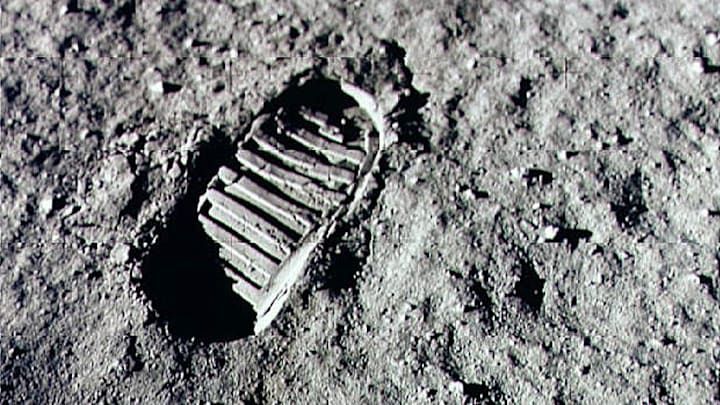It has been more than 50 years since humans last set foot on the moon, but NASA and other space agencies are planning their return. When the next class of astronauts sets foot on the lunar surface, they’ll see objects left behind by their predecessors along with dust, craters, and abandoned spacecraft. Here are just a few of the oddest things one might find.
- Two Golf Balls
- The Fallen Astronaut
- A Piece of Lava
- A Plaque Announcing the Moon Chapter of the University of Michigan Alumni Association
- A Blank Photograph
- A Suggestive Andy Warhol Drawing
- A Message from Queen Elizabeth II
Two Golf Balls
Alan Shepard holds the distinction of being the fifth and oldest person to walk on the moon, but he’s also the first person to play a round of golf there. Using a Wilson six-iron club head attached to a lunar sample scoop handle, Shepard made two drives: the first swing was “more dirt than ball,” but the second ball went—as he described it—"miles and miles and miles." Shepard brought the club back to Earth (it’s in the United States Golf Association Museum in New Jersey), but didn’t have enough time to retrieve the balls.
The Fallen Astronaut

There isn’t much art on the moon, but there’s more than you might expect. One famous example is Fallen Astronaut, a 3.3-inch aluminum model placed face-down the surface by the crew of Apollo 15. Intended, according to the accompanying plaque, to commemorate those who have died while pursuing space exploration, the sculpture was created by Belgian artist Paul Van Hoeydonck, but despite the honor of having the first sculpture on the moon, Van Hoeydonck said he wanted it to be placed upright and that it represents all humanity.
A Piece of Lava
In a move that could seriously confuse lunar geologists of the future, Apollo 15 astronaut James Irwin left a small chunk of lava on the moon. He had taken it from Devil’s Lake near Bend, Oregon, where NASA sent its astronauts to practice taking rock samples. Each astronaut was hosted by locals, and Irwin was paired with building inspector Floyd Watson. Five years later, upon learning that Irwin was going to the moon, Watson asked Irwin if he’d take the rock up there with him. Irwin did—and, as proof, he sent Watson a photograph of the shard with a handwritten note stating “Oregon Lava on the Moon!”
A Plaque Announcing the Moon Chapter of the University of Michigan Alumni Association
The three astronauts of Apollo 15—David Scott, James Irwin, and Alfred Worden— founded the first space-based chapter of their university’s alumni association.
All three had attended the University of Michigan, so they left behind a small plaque containing the words, “This is to certify that the University of Michigan Club of the Moon is a duly constituted unit of the Alumni Association and entitled to all the rights and privileges under the Association’s Constitution.”
A Blank Photograph

Lots of astronauts took photos on the moon, but Charles Duke took a photo to the moon. While on the Apollo 16 mission, he used the opportunity to place a photograph of his family up there. It shows him, his wife Dorothy, and their sons Charles and Thomas sitting on a bench. The back reads "This is the family of Astronaut Duke from Planet Earth. Landed on the moon, April 1972."
Unfortunately, sunlight is harsh on the moon, temperatures are extreme, and solar radiation is untempered by any significant magnetosphere for most of its orbit. Photographic prints fade pretty quickly, even under relatively controlled conditions, so after more than 50 years, there’s very little image left in the photo.
A Suggestive Andy Warhol Drawing
When Apollo 12 went to the moon in late 1969 the crew took a tiny ceramic wafer containing drawings by six prominent artists. Titled Moon Museum, it included material from Robert Rauschenberg, David Novros, John Chamberlain, Claes Oldenburg, Forrest Myers, and Andy Warhol, and was unofficially attached to the leg of the Intrepid landing module by an aircraft engineer. The module was left behind when the astronauts returned to the orbiting capsule, so the artwork should still be up there. Warhol’s drawing in the top left corner was (allegedly) a stylized version of his initials—but was considered X-rated by many who saw it.
A Message from Queen Elizabeth II
Her Majesty never went to space, but Apollo 11 astronauts did carry a piece of the British monarchy up there with it. When they went to the moon, Neil Armstrong and Buzz Aldrin were asked to leave behind a silicon disk measuring 1.5 inches across. It contains, in microscopic writing, goodwill messages from prominent figures and leaders of nearly 75 countries, including Pope Paul VI, Indira Gandhi, and Queen Elizabeth II as well as statements from Dwight Eisenhower, John F. Kennedy, Lyndon Johnson, and Richard Nixon. It was designed to remain intact for thousands of years and serves as a reminder that, despite turmoil of the Cold War, leaders across the globe were united in their optimism about space exploration.
Discover More Stories About Humans in Space:
A version of this article was published in 2016; it has been updated for 2025.
